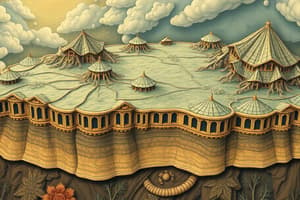Podcast
Questions and Answers
What two primary types of crust make up the lithosphere?
What two primary types of crust make up the lithosphere?
- Continental and basalt
- Oceanic and basalt (correct)
- Continental and silica
- Oceanic and granite
What type of rock is the oceanic crust primarily made of?
What type of rock is the oceanic crust primarily made of?
- Aluminum
- Silica
- Granite
- Basalt (correct)
What is the role of the asthenosphere in plate tectonics?
What is the role of the asthenosphere in plate tectonics?
- Lubrication (correct)
- Erosion
- Sedimentation
- Lithification
Why are continents generally at a higher elevation compared to the ocean floor?
Why are continents generally at a higher elevation compared to the ocean floor?
Which geological events are caused by the movement of tectonic plates?
Which geological events are caused by the movement of tectonic plates?
What geological event is caused by the release of built-up energy in the Earth's crust?
What geological event is caused by the release of built-up energy in the Earth's crust?
What is the primary trigger for tsunamis according to the text?
What is the primary trigger for tsunamis according to the text?
What is the primary cause of seismic activity like earthquakes?
What is the primary cause of seismic activity like earthquakes?
How does the lithosphere influence plate tectonics, earthquakes, tsunamis, rock types, and mineral compositions?
How does the lithosphere influence plate tectonics, earthquakes, tsunamis, rock types, and mineral compositions?
Flashcards
What is the lithosphere?
What is the lithosphere?
The solid, outermost layer of Earth, comprising the crust and upper mantle.
What is oceanic crust?
What is oceanic crust?
Relatively thin and dense crust, composed of basalt rock rich in silica and magnesium.
What is continental crust?
What is continental crust?
Crust mainly composed of granite rocks rich in silica and aluminum, less dense than oceanic crust.
What are tectonic plates?
What are tectonic plates?
Signup and view all the flashcards
What is the asthenosphere?
What is the asthenosphere?
Signup and view all the flashcards
What are faults?
What are faults?
Signup and view all the flashcards
What are tsunamis?
What are tsunamis?
Signup and view all the flashcards
What is an earthquake?
What is an earthquake?
Signup and view all the flashcards
Study Notes
Lithosphere
Overview
The lithosphere is the solid, outer part of Earth, including the brittle upper portion of the mantle and the crust. It is the outermost layer of the planet and is responsible for many of the Earth's geological processes. The term "lithosphere" is derived from the Greek words "lithos," meaning stone, and "sphaira," meaning globe or ball.
Composition
The lithosphere is composed of two primary types of crust: oceanic and continental. Oceanic crust is relatively thin and dense, made up of basalt rock rich in silica and magnesium. It ranges in thickness from just a few miles at ocean-spreading centers to 60 to 90 miles under mature ocean basins. Continental crust, on the other hand, is mainly composed of granite rocks rich in silica and aluminum and can reach thicknesses of up to 190 miles. Continents are at a higher elevation than the ocean floor because continental crust is less dense than oceanic crust.
Plate Tectonics
The lithosphere is divided into sections known as tectonic plates. There are seven major plates and eight minor plates. The asthenosphere, a partially molten layer beneath the lithosphere, acts as a lubricant for the plates, allowing them to slide along, bump into, and rub past each other. This movement leads to geological events such as volcanic eruptions and earthquakes. Plate tectonics also shapes the Earth's landforms, including the Himalayas, which were formed by the collision of the Indian and Eurasian plates.
Earthquakes and Tsunamis
Earthquakes are caused by the release of built-up energy in the Earth's crust. They occur along faults, which are fractures in the Earth's crust where rocks can move along each other. Seismic activity, such as earthquakes, can cause tsunamis, which are large ocean waves triggered by disturbances in the ocean floor.
Lithospheres of Other Planets
The lithosphere is not unique to Earth; it also exists on other terrestrial planets. For example, Mars has a lithosphere that is similar in composition to Earth's, but it is much thinner due to the planet's smaller size and lower overall temperature. Venus, on the other hand, has a thicker lithosphere due to its higher temperatures and slower plate tectonic processes.
Conclusion
The lithosphere is a vital component of the Earth's geological structure, influencing plate tectonics, earthquakes, tsunamis, and the distribution of rock types and mineral compositions. It is a complex system that is still being studied and understood, with new discoveries and insights being made regularly.
Studying That Suits You
Use AI to generate personalized quizzes and flashcards to suit your learning preferences.




